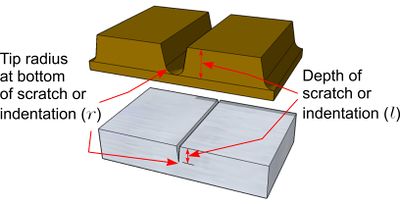Stress Concentration: Difference between revisions
From DT Online
(Stress Concentration) |
No edit summary |
||
| (7 intermediate revisions by the same user not shown) | |||
| Line 1: | Line 1: | ||
When materials are placed under stress care should be taken to ensure that all edges and surfaces are polished and smooth. Forces will concentrate around even the smallest surface imperfection causing the component to fail sooner than predicted by a theoretical calculation. | When materials are placed under stress care should be taken to ensure that all edges and surfaces are polished and smooth. Forces will concentrate around even the smallest surface imperfection causing the component to fail sooner than predicted by a theoretical calculation. | ||
[[File:StressConcentration.jpg| | [[File:StressConcentration.jpg|400px|right]] | ||
This can be catastrophic, as in the case of the [http://en.wikipedia.org/wiki/BOAC_Flight_781 '''Comet airliner disaster'''], or it can be an intended consequence, as in the case of a bar of chocolate for example. | This can be catastrophic, as in the case of the [http://en.wikipedia.org/wiki/BOAC_Flight_781 '''Comet airliner disaster'''], or it can be an intended consequence, as in the case of a bar of chocolate for example. | ||
Calculating the increase in stress '''''(σ<sub>max</sub>)''''' is very complex but for a simple scratch or indentation it can be estimated as follows: | Calculating the [http://en.wikipedia.org/wiki/Stress_concentration '''stress concentration'''], or increase in stress, '''''(σ<sub>max</sub>)''''' is very complex but for a simple scratch or indentation it can be estimated as follows: | ||
[[File:StressConcentrationEquation.jpg|400px|center]] | [[File:StressConcentrationEquation.jpg|400px|center]] | ||
| Line 10: | Line 10: | ||
* '''''l''''' = length or depth of scratch | * '''''l''''' = length or depth of scratch | ||
* '''''r''''' = the tip radius at the bottom of the scratch | * '''''r''''' = the tip radius at the bottom of the scratch | ||
* Capital '''I''' - Moment of Inertia for the material | * Capital '''I''' - '''[[Moment of Inertia]]''' for the material | ||
---- | ---- | ||
<span style="color: green">'''Note:''' | <span style="color: green">'''Note:''' | ||
| Line 16: | Line 16: | ||
</span> | </span> | ||
---- | ---- | ||
[[Category:Secondary]] | |||
[[Category:Structures]] | |||
[[Category:Terminology]] | |||
Latest revision as of 15:30, 22 April 2016
When materials are placed under stress care should be taken to ensure that all edges and surfaces are polished and smooth. Forces will concentrate around even the smallest surface imperfection causing the component to fail sooner than predicted by a theoretical calculation.
This can be catastrophic, as in the case of the Comet airliner disaster, or it can be an intended consequence, as in the case of a bar of chocolate for example.
Calculating the stress concentration, or increase in stress, (σmax) is very complex but for a simple scratch or indentation it can be estimated as follows:
Where:
- l = length or depth of scratch
- r = the tip radius at the bottom of the scratch
- Capital I - Moment of Inertia for the material
Note: The key point to note is that the best way to reduce the increase in stress created by a scratch or cut is to increase the radius at the tip - and that is why driling a hole at the end of a cut or tear can stop it spreading further!

